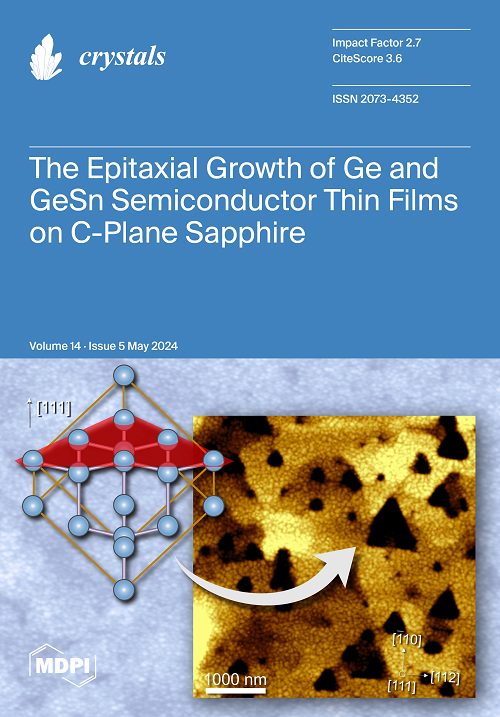Heat Treatment Post-Processing for the Improved Mechanical Properties of Scalmalloy® Processed via Directed Energy Deposition
IF 2.4
4区 材料科学
Q2 CRYSTALLOGRAPHY
引用次数: 0
Abstract
As high-strength aluminum alloys present several processability issues with additive manufacturing (AM), Scalmalloy®, an Al-Mg-Sc-Zr-based alloy, has been developed. This alloy is age-hardenable, allowing it to precipitate out a strengthening precipitate phase, Al3(Sc,Zr). The manufacturer recommends a single-stage aging treatment at 325 °C for 4 h; however, the majority of the literature studies utilize a powder bed processing known as selective laser melting (SLM) over powder-fed processing directed energy deposition (DED). This study addresses the lack of information on heat treatments for DED fabrication by exploring the application of artificial aging temperatures of 300–400 °C for 2, 4, and 6 h to: 1. determine the impact on the microstructural evolution and mechanical performance and 2. determine whether the recommended treatment for Scalmalloy® is appropriate for DED fabrication. Tensile testing determined that low-temperature treatments exhibited no visible dependence on time (2–6 h); however, time becomes influential at higher temperatures starting at 350 °C. The temperature plays a considerable role in the mechanical and microstructural behaviors of DED Scalmalloy®. The highest tensile strength was noted at 300 °C (384 MPa, 21.6% increase), but all heat-treated cases resulted in an improvement over the as-built case. This investigation established that increasing the treatment temperature resulted in a decreasing trend for the tensile strength that held over time. Elongation at 2 h displayed a near parabolic trend that peaks at 350 °C (20%) and falls with higher temperatures. At the 4 h treatment, a slight decreasing trend was noticed for elongation. No visible change was observed for elongation at 6 h, with elongation values remaining fairly consistent. The microstructural evolution, including micron-sized and nano-sized Al3(Sc,Zr) and grain size, was examined, and coarsening effects were noted with the increase in the temperature. It is recommended that treatment be conducted at 300 °C to achieve the precipitation of the strengthening Al3(Sc,Zr) phase while minimizing coarsening.热处理后处理提高了通过定向能沉积技术加工的 Scalmalloy® 的机械性能
由于高强度铝合金在增材制造(AM)中存在一些可加工性问题,因此开发了一种 Al-Mg-Sc-Zr 基合金 Scalmalloy®。这种合金具有时效硬化性,可析出强化沉淀相 Al3(Sc,Zr)。制造商建议在 325 °C 下进行 4 小时的单级时效处理;然而,大多数文献研究采用的是一种称为选择性激光熔化(SLM)的粉末床加工方法,而不是粉末馈送加工的定向能沉积(DED)方法。本研究探讨了 300-400 °C 人工老化温度下持续 2、4 和 6 小时的应用,以解决定向能沉积制造热处理信息缺乏的问题:1. 确定对微观结构演变和机械性能的影响;2. 确定推荐的 Scalmalloy® 处理方法是否适合 DED 制造。拉伸测试表明,低温处理对时间(2-6 小时)没有明显的依赖性;但是,从 350 °C 开始,温度越高,时间越有影响。温度对 DED Scalmalloy® 的机械和微观结构行为起着重要作用。拉伸强度在 300 ℃ 时最高(384 兆帕,增加 21.6%),但所有热处理情况都比坯料情况有所改善。这项研究表明,提高处理温度会导致拉伸强度呈下降趋势,而且这种趋势会随着时间的推移而持续。2 小时后的伸长率呈现近似抛物线的趋势,在 350 °C 时达到峰值(20%),温度越高,伸长率越低。在 4 小时的处理过程中,伸长率呈轻微下降趋势。6 小时后,伸长率没有明显变化,伸长率值保持相当一致。对微观结构演变(包括微米级和纳米级 Al3(Sc,Zr)和晶粒大小)进行了研究,发现随着温度的升高,微观结构会发生粗化效应。建议在 300 °C 下进行处理,以实现强化 Al3(Sc,Zr)相的析出,同时尽量减少粗化。
本文章由计算机程序翻译,如有差异,请以英文原文为准。
求助全文
约1分钟内获得全文
求助全文
来源期刊

Crystals
CRYSTALLOGRAPHYMATERIALS SCIENCE, MULTIDIS-MATERIALS SCIENCE, MULTIDISCIPLINARY
CiteScore
4.20
自引率
11.10%
发文量
1527
审稿时长
16.12 days
期刊介绍:
Crystals (ISSN 2073-4352) is an open access journal that covers all aspects of crystalline material research. Crystals can act as a reference, and as a publication resource, to the community. It publishes reviews, regular research articles, and short communications. Our aim is to encourage scientists to publish their experimental and theoretical results in as much detail as possible. Therefore, there is no restriction on article length. Full experimental details must be provided to enable the results to be reproduced. Crystals provides a forum for the advancement of our understanding of the nucleation, growth, processing, and characterization of crystalline materials. Their mechanical, chemical, electronic, magnetic, and optical properties, and their diverse applications, are all considered to be of importance.
 求助内容:
求助内容: 应助结果提醒方式:
应助结果提醒方式:


